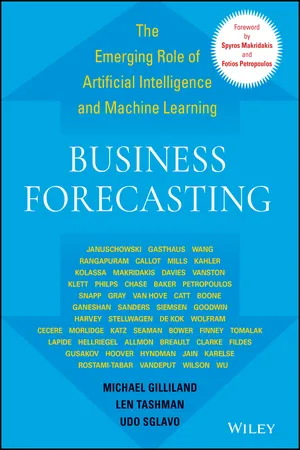
Business Forecasting
The Emerging Role of Artificial Intelligence and Machine Learning
- English
- ePUB (mobile friendly)
- Available on iOS & Android
Business Forecasting
The Emerging Role of Artificial Intelligence and Machine Learning
About this book
Discover the role of machine learning and artificial intelligence in business forecasting from some of the brightest minds in the field
In Business Forecasting: The Emerging Role of Artificial Intelligence and Machine Learning accomplished authors Michael Gilliland, Len Tashman, and Udo Sglavo deliver relevant and timely insights from some of the most important and influential authors in the field of forecasting. You'll learn about the role played by machine learning and AI in the forecasting process and discover brand-new research, case studies, and thoughtful discussions covering an array of practical topics. The book offers multiple perspectives on issues like monitoring forecast performance, forecasting process, communication and accountability for forecasts, and the use of big data in forecasting.
You will find:
- Discussions on deep learning in forecasting, including current trends and challenges
- Explorations of neural network-based forecasting strategies
- A treatment of the future of artificial intelligence in business forecasting
- Analyses of forecasting methods, including modeling, selection, and monitoring
In addition to the Foreword by renowned researchers Spyros Makridakis and Fotios Petropoulos, the book also includes 16 "opinion/editorial" Afterwords by a diverse range of top academics, consultants, vendors, and industry practitioners, each providing their own unique vision of the issues, current state, and future direction of business forecasting.
Perfect for financial controllers, chief financial officers, business analysts, forecast analysts, and demand planners, Business Forecasting will also earn a place in the libraries of other executives and managers who seek a one-stop resource to help them critically assess and improve their own organization's forecasting efforts.
Frequently asked questions
- Essential is ideal for learners and professionals who enjoy exploring a wide range of subjects. Access the Essential Library with 800,000+ trusted titles and best-sellers across business, personal growth, and the humanities. Includes unlimited reading time and Standard Read Aloud voice.
- Complete: Perfect for advanced learners and researchers needing full, unrestricted access. Unlock 1.4M+ books across hundreds of subjects, including academic and specialized titles. The Complete Plan also includes advanced features like Premium Read Aloud and Research Assistant.
Please note we cannot support devices running on iOS 13 and Android 7 or earlier. Learn more about using the app.
Information
CHAPTER 1
Artificial Intelligence and Machine Learning in Forecasting
- Will AI/ML fundamentally change the way we do forecasting?
- Will AI/ML fundamentally improve our forecasting performance (both accuracy, and our understanding of forecast uncertainty)?
- Can AI/ML address the psychological and process issues that so greatly impact the real-life practice of forecasting?
1.1 DEEP LEARNING FOR FORECASTING*
Introduction
Limitations of the Classical Methods
Table of contents
- Cover
- Table of Contents
- Title Page
- Copyright
- Dedication
- Foreword
- Preface
- State of the Art
- CHAPTER 1: Artificial Intelligence and Machine Learning in Forecasting
- CHAPTER 2: Big Data in Forecasting
- CHAPTER 3: Forecasting Methods: Modeling, Selection, and Monitoring
- CHAPTER 4: Forecasting Performance
- CHAPTER 5: Forecasting Process: Communication, Accountability, and S&OP
- Afterwords
- About the Editors
- Index
- End User License Agreement